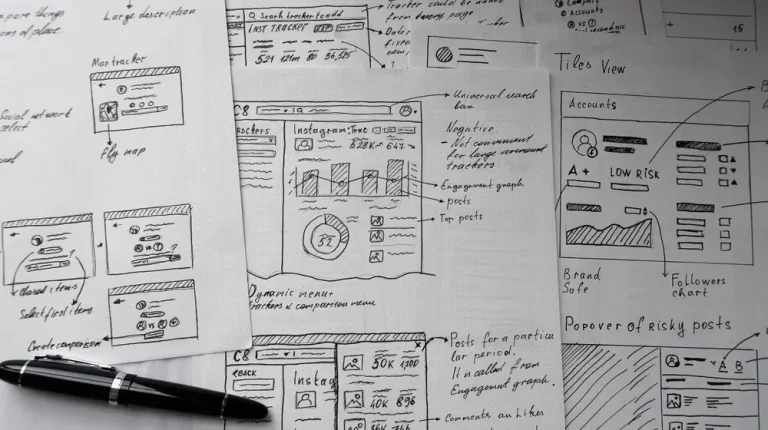The Benefits of a Well-Designed E-Commerce Site for Growing Your Brand

In the digital era, an e-commerce website serves as a crucial touchpoint between your brand and potential customers. Its design and functionality significantly impact not only the user experience but also your brand’s growth and success. A well-designed e-commerce site is more than just an online store; it is a powerful tool for enhancing brand identity, driving sales, and fostering customer loyalty. In this comprehensive guide, we will explore the myriad benefits of a well-designed e-commerce site and how it can contribute to growing your brand. We will cover essential design elements, user experience considerations, and strategies to leverage your e-commerce site for optimal brand growth.
1. Enhancing Brand Identity
A well-designed e-commerce site plays a vital role in establishing and reinforcing your brand’s identity. It provides an opportunity to visually communicate your brand’s values, personality, and unique selling propositions.
1.1 Visual Consistency
Visual consistency across your e-commerce site helps in reinforcing brand recognition. Consistent use of colours, fonts, and imagery ensures that your site aligns with your overall brand identity.
- Brand Colours: Use your brand’s colours strategically to create a cohesive look that resonates with your audience and distinguishes your brand from competitors.
- Typography: Choose fonts that reflect your brand’s personality. Consistent typography enhances readability and reinforces your brand’s style.
- Imagery: High-quality images that align with your brand’s aesthetic can enhance the overall visual appeal of your site and help build a strong brand presence.
1.2 Professionalism and Trustworthiness
A professional-looking e-commerce site conveys credibility and builds trust with potential customers. A well-designed site with clear navigation, a user-friendly interface, and high-quality content signals that your business is established and reliable.
- First Impressions: A visually appealing and well-structured site creates a positive first impression, making visitors more likely to trust your brand and explore further.
- Customer Confidence: Professional design elements, such as clear contact information, secure payment options, and well-organised product listings, reassure customers and encourage them to make purchases.
1.3 Brand Storytelling
Your e-commerce site is a platform for storytelling, allowing you to convey your brand’s narrative and values. Through engaging content, visuals, and interactive features, you can share your brand’s story and connect with your audience on a deeper level.
- About Us Page: Use the “About Us” page to tell the story of your brand, its mission, and its values. This page helps customers understand who you are and why they should choose your products.
- Content Marketing: Incorporate blog posts, videos, and customer testimonials to share your brand’s journey and build a connection with your audience.
2. Improving User Experience
User experience (UX) is a critical factor in the success of an e-commerce site. A well-designed site ensures that visitors can easily find what they’re looking for and complete their purchases with minimal friction.
2.1 Easy Navigation
Intuitive navigation helps users find products and information quickly, enhancing their overall experience on your site.
- Clear Menu Structure: Organise your site’s menu with clear categories and subcategories that make it easy for users to browse different product types and collections.
- Search Functionality: Implement a powerful search feature with filters and sorting options to help users quickly locate specific products or brands.
2.2 Mobile Responsiveness
With the growing use of mobile devices for online shopping, having a mobile-responsive design is essential. A mobile-friendly site adapts to different screen sizes and provides a seamless experience across devices.
- Responsive Design: Ensure that your e-commerce site is designed to adjust its layout and content based on the device being used, whether it’s a smartphone, tablet, or desktop computer.
- Touchscreen Compatibility: Optimise buttons, links, and forms for touchscreen navigation to improve usability on mobile devices.
2.3 Fast Loading Times
Page speed is a crucial factor in user experience and can significantly impact your site’s performance.
- Optimised Images: Compress images and use appropriate formats to reduce loading times without compromising visual quality.
- Efficient Code: Minimise and optimise your site’s code to enhance performance and reduce latency.
2.4 Secure and Simple Checkout Process
A streamlined and secure checkout process reduces cart abandonment and encourages customers to complete their purchases.
- Simplified Forms: Keep checkout forms short and user-friendly, requesting only essential information to expedite the process.
- Multiple Payment Options: Offer various payment methods to accommodate different preferences and increase the likelihood of conversion.
- Security Features: Display security badges and use encryption to reassure customers that their payment information is protected.
3. Boosting Sales and Conversions
A well-designed e-commerce site can drive sales and improve conversion rates by implementing features and strategies that enhance the shopping experience and encourage purchases.
3.1 Effective Product Presentation
How you present your products on your e-commerce site can influence purchasing decisions.
- High-Quality Product Images: Use high-resolution images from multiple angles to showcase products effectively. Consider adding zoom functionality to allow users to view details up close.
- Detailed Product Descriptions: Provide comprehensive product descriptions that highlight key features, benefits, and specifications. Include relevant keywords to improve search visibility.
- Product Reviews and Ratings: Display customer reviews and ratings to build trust and provide social proof. Positive reviews can persuade potential buyers to make a purchase.
3.2 Personalisation
Personalisation enhances the shopping experience by tailoring content and recommendations to individual users.
- Personalised Recommendations: Use algorithms to suggest products based on users’ browsing and purchasing history. Personalised recommendations can increase cross-sells and upsells.
- Dynamic Content: Customise banners, offers, and messaging based on user behaviour, location, and preferences.
3.3 Promotions and Discounts
Offering promotions and discounts can incentivise purchases and boost sales.
- Limited-Time Offers: Create urgency with limited-time offers and flash sales to encourage immediate action.
- Discount Codes: Provide discount codes for new customers, repeat buyers, or specific product categories to drive conversions and reward loyalty.
- Free Shipping: Offer free shipping thresholds or promotions to reduce barriers to purchase and increase average order value.
3.4 Abandoned Cart Recovery
Recovering abandoned carts can significantly boost sales by re-engaging customers who have left without completing their purchase.
- Abandoned Cart Emails: Send follow-up emails to users who have abandoned their carts, reminding them of their selected items and offering incentives to complete their purchase.
- Retargeting Ads: Use retargeting ads to reach users who have visited your site but haven’t converted. Display ads featuring their abandoned products to encourage them to return and complete their purchase.
4. Building Customer Loyalty
A well-designed e-commerce site not only attracts customers but also fosters loyalty and repeat business through engaging features and excellent service.
4.1 User-Friendly Account Management
Providing a user-friendly account management system enhances the customer experience and encourages repeat purchases.
- Easy Account Creation: Allow users to create accounts quickly and easily, offering options for social media logins or guest checkouts.
- Order History: Provide access to order history and tracking information, enabling customers to view past purchases and monitor the status of current orders.
- Wishlist Functionality: Enable users to create and manage wishlists for future purchases, making it easier for them to find and buy products they’re interested in.
4.2 Customer Support
Excellent customer support enhances customer satisfaction and fosters loyalty.
- Live Chat: Implement live chat functionality to provide real-time assistance and answer customer queries promptly.
- Help Centre: Create a comprehensive help centre with FAQs, guides, and support resources to assist customers with common issues and questions.
- Contact Options: Offer multiple contact options, such as email, phone support, and social media channels, to accommodate different preferences.
4.3 Loyalty Programs
Loyalty programs incentivise repeat purchases and reward customer loyalty.
- Points and Rewards: Implement a points-based system where customers earn rewards for purchases, reviews, and referrals.
- Exclusive Offers: Provide exclusive offers, early access to sales, and special discounts to loyalty programme members.
4.4 Customer Feedback and Reviews
Encouraging and responding to customer feedback helps build trust and improve your offerings.
- Feedback Surveys: Regularly collect feedback through surveys to understand customer satisfaction and identify areas for improvement.
- Respond to Reviews: Engage with customer reviews by thanking reviewers and addressing any concerns or issues raised.
5. Leveraging Analytics and Insights
A well-designed e-commerce site provides valuable insights through analytics, helping you make informed decisions and optimise your strategy.
5.1 Track Key Metrics
Monitor key performance metrics to evaluate the effectiveness of your e-commerce site and identify areas for improvement.
- Traffic Sources: Analyse traffic sources to understand where visitors are coming from and optimise your marketing efforts.
- Conversion Rates: Measure conversion rates to assess the effectiveness of your site in turning visitors into customers.
- Average Order Value: Track the average order value to gauge the impact of your pricing strategies and upselling efforts.
5.2 User Behaviour Analysis
Understanding user behaviour on your site helps identify patterns and optimise the user experience.
- Heatmaps: Use heatmaps to visualise where users click, scroll, and spend time on your site. This information helps identify areas of interest and potential issues.
- Session Recordings: Review session recordings to observe how users navigate your site and identify obstacles or friction points.
5.3 A/B Testing
Conduct A/B testing to compare different design elements and strategies to determine what works best for your audience.
- Design Elements: Test different layouts, colours, and calls-to-action to identify the most effective design choices.
- Content Variations: Experiment with different content formats, headlines and messaging to optimise engagement and conversions.
6. Conclusion
A well-designed e-commerce site is a cornerstone of a successful online business. It enhances brand identity, improves user experience, boosts sales and conversions, and fosters customer loyalty. By focusing on key design elements, user experience considerations, and leveraging analytics, you can create an e-commerce site that not only meets but exceeds customer expectations.
Investing in a well-designed e-commerce site is an investment in your brand’s future growth and success. It provides the foundation for building strong customer relationships, driving sales, and achieving long-term business objectives. As you continuously optimise and adapt your site to meet evolving customer needs and industry trends, you’ll position your brand for sustained success in the competitive e-commerce landscape.
Contact Us
You can contact us on Whatsapp:
or fill up the contact form


